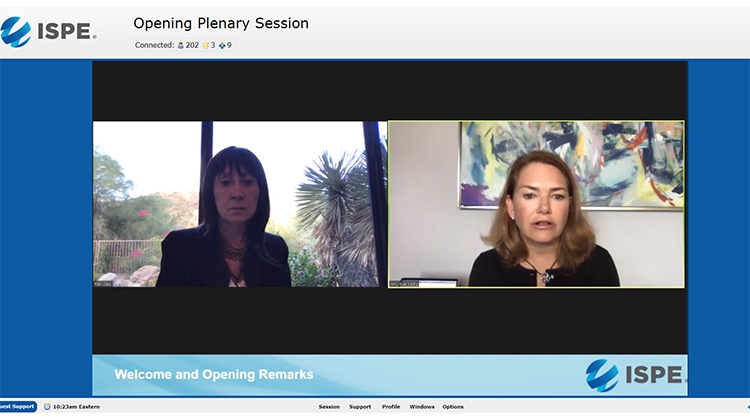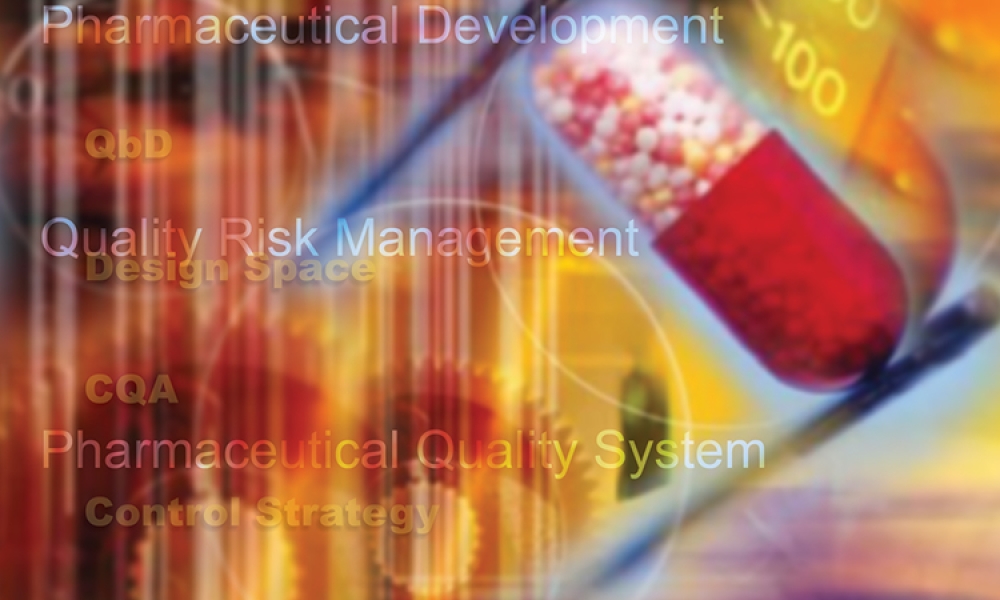2020 ISPE Annual Meeting & Expo Opening Plenary: New Therapies, New Approaches

2020 and the COVID-19 pandemic have presented tremendous challenge to the world and the pharmaceutical industry—but from the pandemic has come stepped up development of vaccines and treatments, increased urgency to address supply chain challenges, and forging ahead to develop and expand of cell and gene therapies. There are lessons to learn from the industry adaptation during these months, including the importance of partnerships and collaboration within the industry and with regulators and governments around the world.
In this environment of change, the 2020 ISPE Annual Meeting & Expo has undergone a change too: to a five-day virtual event featuring over 180 speakers, more than 40 sessions, and over 60 hours of presentations.
“Driving the Future of Pharma,” the theme of this year’s Annual Meeting, is a significant one for ISPE’s 40th anniversary year. “The pandemic has us all looking forward to future and looking forward to what it might mean for us personally and for our industry,” said Tom Hartman, ISPE President and CEO, at the Opening Plenary session on 2 November.
Hartman noted that the Annual Meeting aims to support ISPE’s mission of connecting pharmaceutical knowledge to provide solutions to complex industry challenges, delivering manufacturing and supply chain innovation, and supporting workforce development and collaboration.
Gene Therapy Is Now
“Gene Therapy: The Future is Now” was the theme of the first presentation at the session. Jeffrey Marrazzo, CEO & Co-Founder, Spark Therapeutics, Inc., talked about the growth of the Philadelphia, Pennsylvania-based company.
The fully integrated Spark was launched in 2013, and produced Luxturna, the first gene therapy for a genetic disease to be approved in the US and EU (approved by the FDA approved in 2017; it was launched in 2018). Spark was acquired by the Roche Group in 2019. The company continues on its growth trajectory with approximately 500 employees including about 100 added this year.
Being a fully integrated company “was very important when we began,” Marrazzo said. “We wanted to build on the promise of gene therapy to create capabilities to discover, make, and bring therapies to patients.” Luxturna, a one-time gene therapy for a form of blindness caused by inherited retinal disease, was the company’s first gene therapy; Sparks is working on therapies for blindness, blood clotting disorders, and other diseases. Four therapies are currently in clinical trial and six in preclinical phases.
After the Roche acquisition last year, he said that the company is entering into its second phase, which will involve scaling globally, working with more diseases and impacting more patients, doing more and on a broader scale. Spark will continue with research and combining unique skill sets from Roche to grow its gene therapy work.
“Gene therapy’s time is now,” Marrazzo said. Especially over the last decade, there has been great success in gene therapy R&D, with safer viral vectors largely responsible for creating a lot of potential. Even this year, despite the pandemic, there have been a number of steps to try to push the boundaries of the technology platform and artificial intelligence/machine learning hold promise as well.
In manufacturing, Sparks has successfully scaled up processes and has purchased real estate to expand preclinical R&D, including constructing a technology and manufacturing campus. Spark has expanded its workforce, targeting research and technology, and adding more than 100 people.
There is more to do, he noted: Spark values a diverse workforce with unique viewpoints and experiences. This is “absolutely a requirement to be successful in gene therapy,” Marrazzo said. With so much to learn and so much new in the gene therapy industry, being able to think creatively and having the people to do so are needed.
“The gene therapy future is upon us now and will take its place even more prominently in our industry,” Marazzo said.
Pandemic Lessons to Apply
Paul F. McKenzie, PhD, Chief Operating Officer, CSL Behring, presented on “Engineering and the Pandemic: Lessons for the Future of How We Work.” He urged attendees to learn from what the industry has accomplished during the pandemic to make changes in future operations.
Engineers are well positioned to make changes, McKenzie noted, since they wear many hats including working with scientists and developing solutions such as supply chain modeling to be sure that pharmaceutical therapies get to the patients who need them.
Look to the pandemic “to shape and change how we do work moving forward,” he said, adding “sometimes it takes events like this to rethink how we do our work.”
He outlined lessons learned from the pandemic, and how the industry should apply these for the future:
- Values should be your anchor and your springboard. This is critical to resiliency, prioritizing, and focusing on what will make the greatest impact. At CSL, safeguarding personnel was a central value during the pandemic.
- COVID-19 needs to be a pivot point. Instead of seeing the pandemic as a one-time event, McKenzie said the industry needs to think about how to evolve the business after the crisis. “What can we learn? How can we change day to day work to be successful? How can we use COVID-19 as an opportunity? How can we use it as a platform for the rapid introduction of new technology?” One example: Digital twins and other technologies in supply chains offer the chance to address how to work differently with suppliers.
- Collaboration will continue to be critical to identifying solutions. Partnerships are everywhere in the industry now in manufacturing, research and development, and commercial, as well as regulatory and government relationships. They offer the opportunity to develop rapid solutions. “We’re skilled as engineers—it is our nature to be a connector,” he said. “We need to continue to drive this forward.”
- We need to flex our muscles in new ways. Action on multiple fronts and pursuing different approaches simultaneously tap into knowledge management and information sharing. “How can we stop the same old treadmill in how we work? How to be able to flex our muscles all the time, not just during the pandemic?” Flexible response, prioritization, and focus have been important at CSL in applying this lesson. Working more across alliances is another “muscle” to be flexed. McKenzie cited vaccine manufacturing and distribution as one example.
- Pandemic preparedness is critical. In other words, future pandemics and crises should be planned for and “it is critical that we learn from this.” Advanced manufacturing and supply chain are critical. “Drive a new reality,” he said. “Take advantage of the pandemic, which has been so devastating for all of us, and really change and adopt technologies to drive advanced manufacturing and supply chain technologies.” He cited unique discussions with regulatory agencies as an example of actions that have led to changes.
McKenzie talked about some ways CSL has been applying these lessons through work on vaccine development for COVID-19 and treatments including hyperimmunes and polyclonal antibodies, and with monoclonal antibodies.
Bright Future for Cell Therapies
Progress with cell therapies were shared in a presentation entitled “Manufacturing Autologous Ex Vivo Genetically Modified Cell Therapies Have Challenges But the Future is Bright” by S. Joseph Tarnowski, PhD, Senior Vice President, R&D, Medicinal Science & Technology, GlaxoSmithKline.
In cell therapies, cells are the medicines and can be genetically modified as treatments. To illustrate the complexity of cell therapies, Tarnowski compared various pharmaceuticals to technological developments: aspirin would be comparable to a bicycle, while somatropine would be like a car, herceptin like an airplane, and cell therapy like the space shuttle. In addition to complexity, he noted the unique supply chain of cell therapies.
Cell therapy is growing, with about 1,000 companies now working in this area, Tarnowski said. In addition to cell therapies, new gene editing tools such as CRISPR (clustered regularly interspaced short palindromic repeats) are coming along that will provide another path in addition to viral vectors.
Tarnowski gave an overview of two types of cell therapies: CAR-T (chimeric antigen receptors), mainly helpful in treating bloodborne cancers and diseases, and TCR-T (T cell receptors), which may be most helpful in addressing solid cancer tumors. He noted that there have been some “remarkable” TCR-T trial results at GSK.
The challenge of pricing these therapies continues, but Tarnowski noted that technology developments may offer an ability to lower cost of goods and thus the prices. He cited bluebird bio’s pricing scale for LentiGlobin, a value-based payment over time-based outcome, as one approach to addressing this challenge. Improvements in the last few years in viral vector manufacturing (viral vectors are a significant part of the cost of cell therapies) is also an encouraging development.
Improvements ahead in cell processing including solving the challenges of T cell manufacture by scaling out and the use of ballrooms for cell process automation.
The industry needs innovative analytical methods for quality control and testing to shorten the time frame. “Patients don’t have time to wait!” Tarnowski said, and automation and rapid testing can help lower the time frame from 30 to 35 days down to a few days. “We’ve got to do better to deliver these products to patients faster.”
Fireside Chat
The final session of the Opening Plenary was a “fireside chat” with Amy Abernethy, MD, PhD, Principal Deputy Commissioner, FDA and Fran Zipp, President & CEO, Lachman Consultant Services, Inc., and Chair of the 2019-2020 ISPE International Board of Directors. Abernethy helps oversee the FDA’s day to day functioning. She also directs special and high-priority cross-cutting initiatives that impact the regulation of drugs, medical devices, tobacco, and food. As acting Chief Information Officer, she oversees the FDA’s data and technical vision and its execution.
Zipp posed questions for Abernethy about her work with the FDA and recent developments.
Progress with technology
Zipp asked about advances in technologies, especially artificial intelligence, and their impact from the FDA viewpoint.
“We are on the precipice,” Abernathy said. “There is a lot of opportunity and the runway is in front of us.” She described three areas of technology, especial artificial intelligence (AI), and their impact from the FDA perspective:
- Artificial intelligence software-based products directly regulated by the FDA, such as software embedded in medical devices including diabetes management systems.
- Artificial intelligence and digital devices or approaches/solutions that are FDA adjacent—often used in evaluating products like artificial intelligence to curate data sets.
- Artificial intelligence and digital solutions the FDA uses in its everyday life—automate/improve efficiency and build familiarity for the FDA on how these work. For instance, AI-based algorithms help predict which container to inspect at borders. She noted that artificial intelligence requires availability of data, building of algorithms in which the FDA has confidence including appropriate transparency, and other core elements. She is seeing these core elements being built across the FDA and the industry.
COVID-19 Impact/Acceleration of Technology
Zipp asked about the acceleration of technology due to COVID-19, and the impact of such acceleration. While some technology has been accelerated due to the pandemic, Abernathy noted the need for acceleration with caution. Some examples of what she has been seeing through the pandemic include three ways that AI and digital solutions have been making an impact:
- Use of distant/remote evaluation, such as telehealth to evaluate patients in clinical trials. The FDA has put forth a number of guidances for these. Flexibilities such as delivery of investigational products to patient homes or clinics near patients have provided information on patient safety in clinical trials and data integrity.
- Development of real-world data sets from electronic health records and other sources. Information on managing supply chain and shortages and performance of diagnostics are occurring in a COVID-19 content, and she expects these will accelerate understanding of real-world data.
- Use of artificial intelligence to create synthetic data sets. These are essentially representations of true underlying data and prove the same patterns, but are privacy sparing. She expects this will continue after the pandemic.
Update on the FDA technology modernization plan
Zipp asked Abernathy for an update about the FDA’s new technology modernization plan that the two originally discussed during their Fireside Chat at the 2019 ISPE Annual Meeting & Expo.
Abernathy revisited the main points of the plan, which is “foundational and important” and has three prongs: (1) to shore up technology and build a cloud-forward infrastructure to leverage the cloud and manage data in shared spaces for more advanced data management and thus to leverage solutions like AI and blockchain; (2) to demonstrate what is possible through a series of use cases of solutions that are possible for the future, such as using AI to figure out which containers to inspect at the border, and an API built to allow direct transfer of 7 and 15 day safety data for INDS to the agency; and (3) opening communication channels with data and technology industries. “We can imagine a new future but we need the technology and data industries to help build it,” Abernathy said.
Despite the pandemic, she said the FDA is eight months ahead of schedule with the action plan. Coming soon will be more information on how the FDA will manage data, use it, and utilize solutions such as AI and blockchain.
FDA Digital Health Center of Excellence
Zipp asked about the FDA’s new Digital Health Center of Excellence, which was launched in September.
Abernathy explained that the new Center will start to be a coordinating zone for understanding, education, regulation, and in time, more of a voice across the agency in all of the different areas related to digital health.
A related issue raised by Zipp is the workforce of the future and the need for “reskilling” workers, especially at the middle-management level, for working with technologies. She asked Abernathy whether this is happening within the FDA.
Abernathy responded that while the “knee jerk” reaction is often that AI experts must be hired, and such sophisticated experience is welcome, the practical reality is that everybody needs to understand the fundamentals and context of these technologies, including risks. She noted that in the FDA community of practice are often people who are not in an AI or computational role, but they have curiosity or other skills and are starting to participate in the conversation about technologies. She believes a program of education and opportunity to support this is important.
“At the end of day, it really is about data.” Data is needed to build algorithms, drive decisions in a distributed fashion, and to understand how to characterize underlying data. She sees data modernization as “a key infrastructure aspect.”
Next Year’s ISPE Annual Meeting & Expo
ISPE is planning for the 2021 ISPE Annual Meeting & Expo in Boston, Massachusetts, on 1 –4 November 2021.









